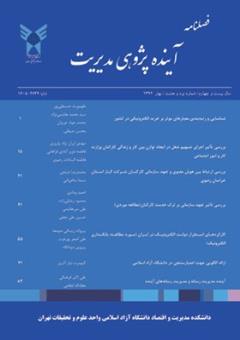تفاوت زنان نسل زد و وای در خریدهای الکترونیکی در طی دوران کووید 19
محورهای موضوعی : آینده پژوهی
1 - عضو تمام وقت گروه مدیریت بازرگانی دانشگاه آزاد اسلامی علوم و تحقیقات
کلید واژه: خرید الکترونیکی, انگیزه لذت جویانه, سودمندی درک شده, هنجارهای ذهنی,
چکیده مقاله :
زمینه: همه گیری پدیده کووید 19 بر روند زندگی افراد تاثیر گذاشته است به طوریکه اکثر افراد در این شرایط خریدهای الکترونیکی را بر خریدهای حضوری ترجیح میدهند. هدف: هدف پژوهش بررسی تفاوت زنان دو نسل زد و وای در خریدهای الکترونیکی در دوران کووید 19 است. روش: پژوهش از نظر هدف، کاربردی و از جهت نوع روش تحقیق جز تحقیقات توصیفی-پیمایشی و همبستگی است. به منظور جمع آوری دادهها پرسشنامهای با طیف 5 گزینهای لیکرت، در میان 400 نفر از مشتریان زنِ فروشگاه های الکترونیکی (دیجی استایل، شیکسون و بانی مد)، به روش نمونه گیری در دسترس توزیع شد که از این تعداد 360 پرسشنامه قابل استفاده برگشت داده شد و از طریق مدل یابی معادلات ساختاری، رد یا تایید فرضیهها مورد آزمون قرار گرفت. یافته: نتایج نشان میدهد تاثیر هر چهار متغیر (هنجار ذهنی بیرونی، هنجار ذهنی درونی، انگیزه لذت جویانه و سودمندی درک شده) بر قصد خرید در هر دو نسل (زد و وای) به صورت مثبت و معنادار است. مقایسه نتایج در بین دو نسل از وجود تفاوت در تاثیر انگیزه لذت جویانه بر قصد خرید حمایت کرده و نشان میدهد که انگیزه لذت جویانه نسل زد در مقایسه با نسل وای تاثیر شدیدتری بر قصد خرید ایفا میکند.
Bachground: The COVID-19 pandemic phenomenon has affected the course of people's lives, so that most people in this situation prefer e-shopping to in-person shopping. Objective: The present study aims at investigating the difference between women of both generations Y and Z in e-shopping during the COVID-19 era. Method: The research is applied in terms of purpose and is descriptive-survey and correlational in terms of the type of research method. In order to collect data, a questionnaire with a 5-point Likert scale was distributed among 400 female customers of e-shops (Digistyle, Shixon and Banimode) through convenience sampling method, of which 360 usable questionnaires was returned and tested by modeling structural equations and rejecting or confirming the hypotheses. Finding: The results indicated that the effect of all four variables (external mental norm, internal mental norm, hedonic motivation and perceived usefulness) is positive and significant on the purchase intention in both generations (Z and Y). Comparison of the results between the two generations supports the existence of differences in the effect of hedonic motivation on the intention to buy and reveals that the hedonic motivation of the generation Z compared to the generation Y has a stronger effect on the purchase intention.


